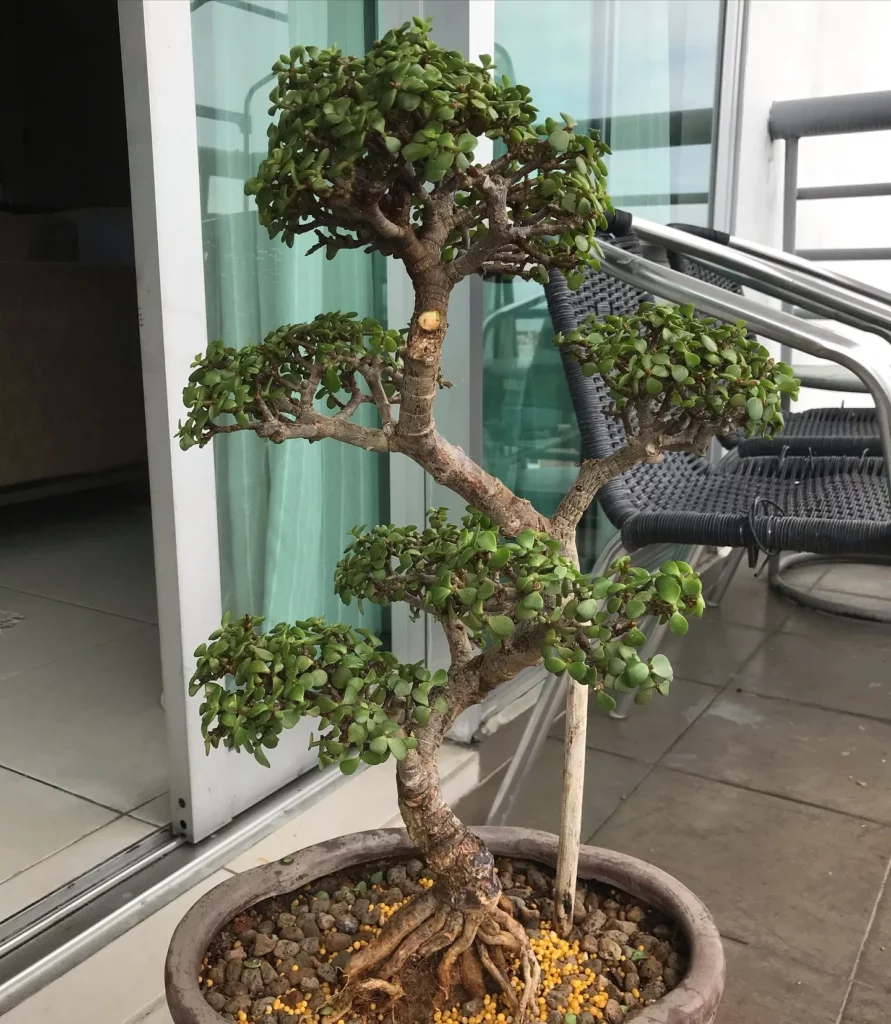To shape a jade bonsai tree, regularly prune the branches and leaves to encourage a desired form and use wire training for branch positioning.
If you’re interested in growing bonsai trees but worried you can’t maintain them or are not keen on dropping one-hundred-plus dollars on a mature tree… read on! I’ll walk you through my simple steps for growing a great beginner bonsai – the dwarf jade – from an inexpensive cutting to a beautiful tree. Bonsai literally means ‘planted in a shallow container’. It’s a common misunderstanding that bonsai trees are a particular species of genetically dwarfed plant. You can actually turn most plants into bonsai, but some are better suited to looking like miniature trees and living in shallow containers than others.
Key Takeaways:
- Shaping a jade bonsai tree is a rewarding and artistic journey.
- Begin with a dwarf jade, a forgiving and low-maintenance option for beginners.
- You can obtain a jade bonsai by finding a cutting or purchasing a young tree.
- Propagate a jade bonsai cutting by rooting it in water and then planting it in soil.
- Caring for a newly planted jade bonsai requires proper sunlight, watering, and monitoring leaf health.
Why Choose Jade Bonsai for Beginners?
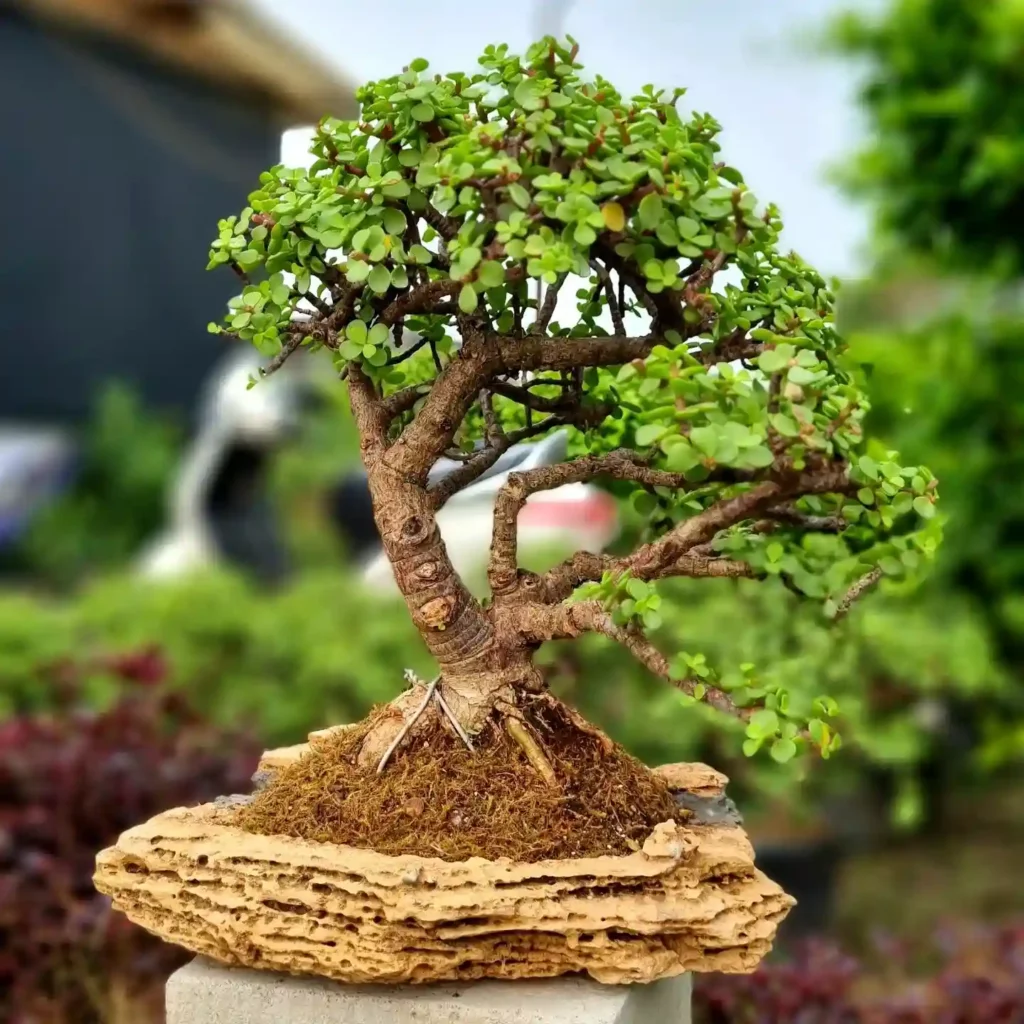
The dwarf jade (also known as elephant bush or portulacaria afra) is a great bonsai tree for beginners. It is forgiving and low-maintenance, making it an ideal choice for those new to bonsai. It is also a long-lived plant and can be easily shaped and grown into a beautiful tree. Additionally, the dwarf jade is a common and inexpensive plant, making it accessible to beginners who may not want to invest a lot of money in a mature bonsai tree.
The Benefits of Choosing Jade Bonsai for Beginners
- Forgiving and Low-Maintenance: Jade bonsai trees are resilient and can tolerate occasional neglect, making them ideal for beginners who may not have extensive gardening experience.
- Longevity: With proper care, jade bonsai trees can live for many years, providing a long-lasting and rewarding bonsai experience.
- Ease of Shaping: Dwarf jade bonsai trees have pliable branches that are easily shaped and trained into desired forms.
- Accessibility: The dwarf jade is a popular and widely available plant, making it easy for beginners to find and purchase.
- Cost-Effective: Compared to mature bonsai trees, dwarf jade plants are relatively inexpensive, allowing beginners to start their bonsai journey without a significant investment.
By choosing a jade bonsai tree as their introduction to bonsai cultivation, beginners can enjoy the process of shaping and caring for their own miniature tree while gaining valuable experience in the art of bonsai. With its forgiving nature, accessibility, and affordability, the dwarf jade is an excellent choice for those venturing into the world of bonsai.
Obtaining a Jade Bonsai Tree
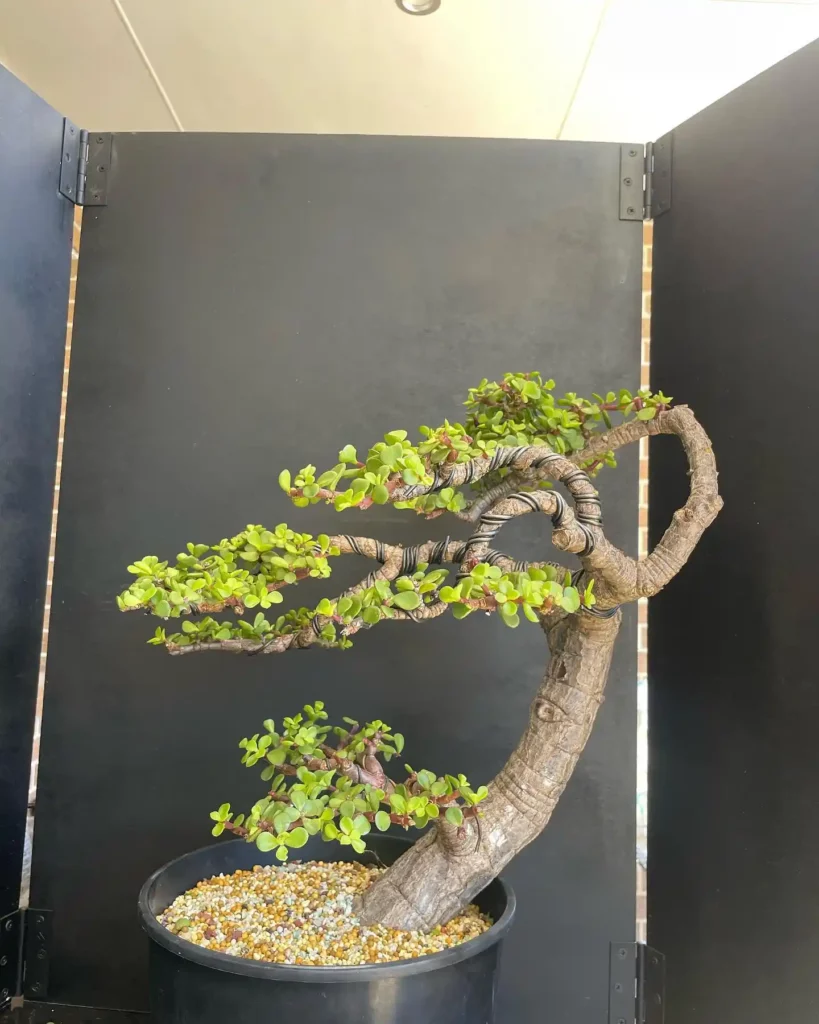
When it comes to obtaining a jade bonsai tree, there are two common options available. You can either find a cutting from a friend or a store, or purchase a young jade bonsai tree. Let’s explore both options in more detail:
Obtaining a Jade Bonsai Cutting
If you choose to obtain a jade bonsai cutting, it can be a great way to start your bonsai journey. Cuttings are typically 4 to 10 inches long and as thick as possible, providing you with a good foundation to grow your bonsai tree. You can ask a friend who already has a jade bonsai tree if they have any cuttings to spare, or check with local nurseries or bonsai stores.
Buying a Young Jade Bonsai Tree
If you prefer a more established starting point, buying a young jade bonsai tree is a great option. These trees will have thinner trunks and a less established shape compared to mature trees, giving you the opportunity to shape and style them according to your artistic vision. You can find young jade bonsai trees at bonsai nurseries, specialized bonsai stores, or online marketplaces.
| Obtaining Method | Features |
|---|---|
| Jade Bonsai Cutting | – 4 to 10 inches long |
| Young Jade Bonsai Tree | – Thinner trunks than mature trees |
| – Less established shape |
Propagating a Jade Bonsai Cutting
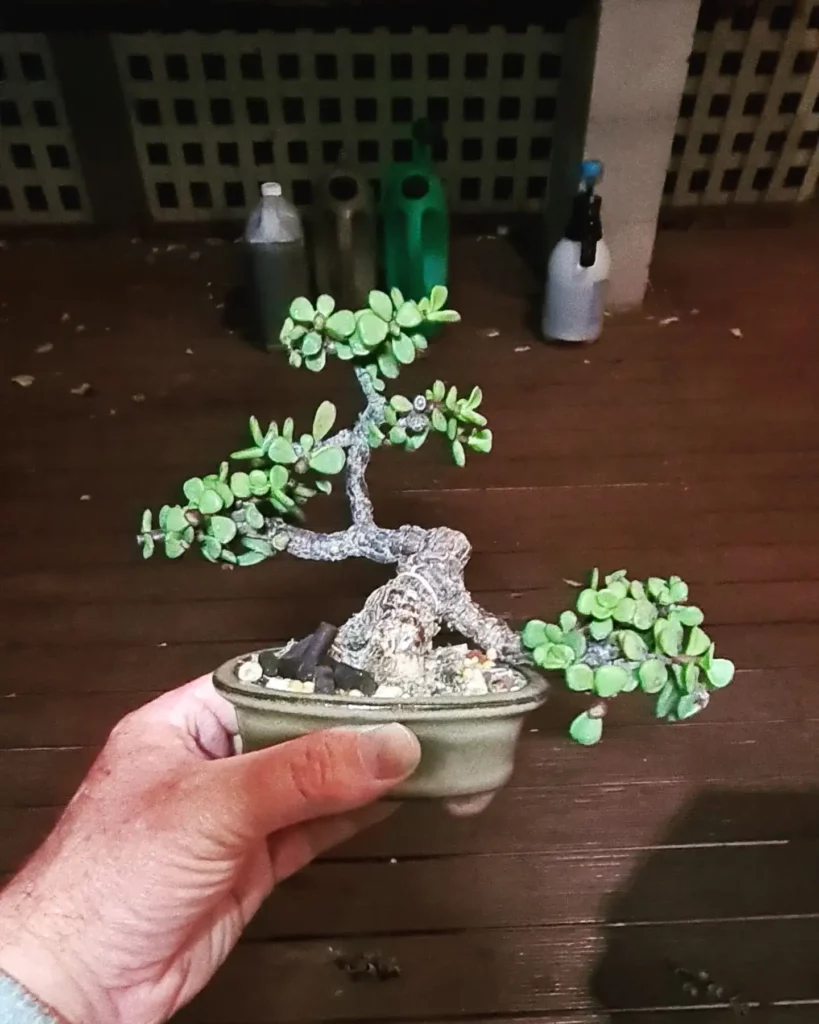
If you’re eager to expand your collection of jade bonsai trees, propagating from cuttings is an excellent method to grow new plants. Not only is it a cost-effective way to obtain more bonsai specimens, but it also allows you to create unique variations of this stunning plant. Follow these simple steps to propagate a jade bonsai cutting and witness the magic of new growth taking root.
No products found.
Gather the Materials
Before you begin, gather the necessary materials to propagate your jade bonsai cutting:
- A healthy jade bonsai cutting, approximately 4 to 10 inches long
- A glass or container
- Water
- Bonsai soil or well-draining cactus soil
- A small pot with drainage holes
Prepare the Cutting
To prepare the jade bonsai cutting for propagation, follow these steps:
- Remove the leaves from the bottom 2 inches of the cutting. This will create a clean stem for rooting.
- Fill a glass or container with 2 inches of water.
- Place the stem of the cutting into the water, ensuring that the cut end is submerged.
Rooting the Cutting
After preparing the cutting, it’s time to encourage the growth of roots:
- Place the glass or container in a well-lit area, but avoid direct sunlight.
- Keep the water level consistent, ensuring that the cut end of the stem remains submerged.
- Wait patiently, as roots will start to appear in a matter of days to a few weeks. Once there is a network of roots about 2 inches long, the cutting is ready for planting.
Planting the Cutting
When the roots have developed, it’s time to plant the cutting in soil:
- Choose a small pot with drainage holes to prevent waterlogged soil.
- Fill the pot with bonsai soil or well-draining cactus soil.
- Gently remove the cutting from the water and carefully plant it in the soil, ensuring that the roots are covered.
- Provide support for the cutting using stakes or wires until its roots are fully established.
Congratulations! You have successfully propagated a jade bonsai cutting. With proper care and maintenance, your new bonsai tree will continue to grow and flourish. Remember to water the plant when the soil is dry and provide it with adequate sunlight to promote healthy growth. Enjoy the satisfaction of nurturing a beautiful bonsai tree that began from a single cutting.
Caring for a Newly Planted Jade Bonsai

Once you have successfully planted your jade bonsai, it is important to provide the proper care to ensure its health and growth. Paying attention to sunlight, watering, and humidity levels will help your bonsai thrive.
1. Sunlight
Jade bonsai trees require ample sunlight to thrive. Place your bonsai in the sunniest spot available, preferably near a south-facing window or on a patio where it can receive direct sunlight. If you’re unable to provide enough natural sunlight, you can supplement it with moderate artificial light to promote healthy growth.
2. Watering
Watering is a crucial aspect of jade bonsai care. It’s important to strike a balance between keeping the soil moist and avoiding overwatering. Water your bonsai when the top inch of soil feels dry to the touch. Use a small watering can or a spray bottle to gently moisten the soil, ensuring that the entire root system receives adequate hydration.
Be cautious not to overwater your jade bonsai, as it is a drought-tolerant plant. Overwatering can cause root rot and other issues. If you notice the leaves becoming limp, withering, or turning yellow, it’s a sign that your bonsai needs watering. However, if the leaves become transparent or turn yellow, it may indicate overwatering.
3. Humidity
Jade bonsai trees prefer warm, low-humidity environments. Aim to maintain a humidity level around 30-50% for optimal growth. If the air in your home is dry, especially during winter months, you can increase humidity around your bonsai by placing it on a humidity tray filled with water or by using a humidifier in the room.
To help you remember these care tips, refer to the table below for a quick guide on caring for your newly planted jade bonsai.
| Care Tips | Action |
|---|---|
| Sunlight | Place in the sunniest spot available; provide moderate artificial light if needed |
| Watering | Water when the top inch of soil is dry; avoid overwatering |
| Humidity | Maintain warm, low-humidity environment with 30-50% humidity levels |
Jade Bonsai Pruning Basics

Pruning is an essential part of shaping a jade bonsai tree. Whether you want a single straight trunk, a branching trunk, or a bonsai forest, proper pruning techniques are crucial to achieving your desired result.
The first pruning session should be conducted in spring or early summer when the jade bonsai is actively growing. This ensures optimal healing and recovery for the plant. It’s important to use sharp pruning tools to make clean cuts, as this minimizes damage to the tree.
Regular pruning is necessary to maintain the desired shape and encourage new growth. Depending on the growth rate and characteristics of your jade bonsai, you might need to prune multiple times throughout the year. Adjust your pruning schedule based on the specific needs of your bonsai tree.
When pruning, keep the following techniques in mind:
- Branch Pruning: Remove any unwanted or excessive branches to maintain the overall shape of your bonsai tree.
- Leaf Pruning: By selectively removing oversized leaves or leaf buds in unwanted places, you can control the leaf density and size of your jade bonsai.
- Root Pruning: Over time, the roots of your jade bonsai tree may become crowded. Root pruning involves gently removing some of the roots to maintain a healthy root system.
Shaping Techniques for Jade Bonsai
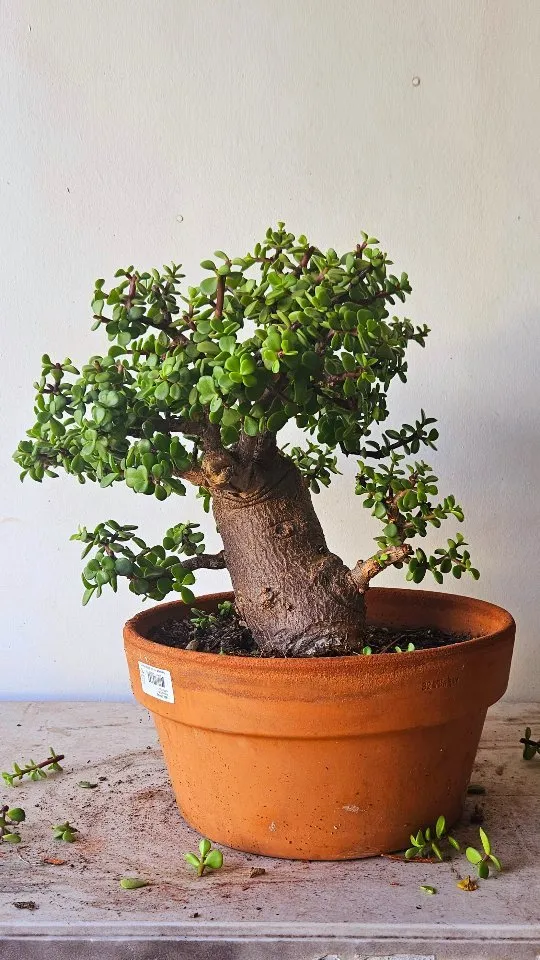
Shaping a jade bonsai tree requires careful techniques to achieve desired forms and artistic expression. Two common methods used in shaping jade bonsai are wiring and coiling. These methods allow for the manipulation of branches and the creation of unique bonsai forms.
Wiring Jade Bonsai
One effective technique for shaping jade bonsai is through wiring. Copper wire is gently wrapped around branches to guide their growth. The wire should be loosely coiled to prevent damage to the branches. By bending the branches incrementally, you can achieve the desired shape without risking breakage. It’s important to remove the wire once the shaping is complete to avoid leaving marks on the branches.
Coiling Jade Bonsai
Another method of shaping jade bonsai is through coiling. This technique involves wrapping branches in a specific pattern to create curved or spiral shapes. Coiling can add visual interest to the bonsai tree and enhance its overall design. Care should be taken to ensure the coiling is done gradually and does not cause harm to the branches.
Pruning for Leaf Density and Size Control
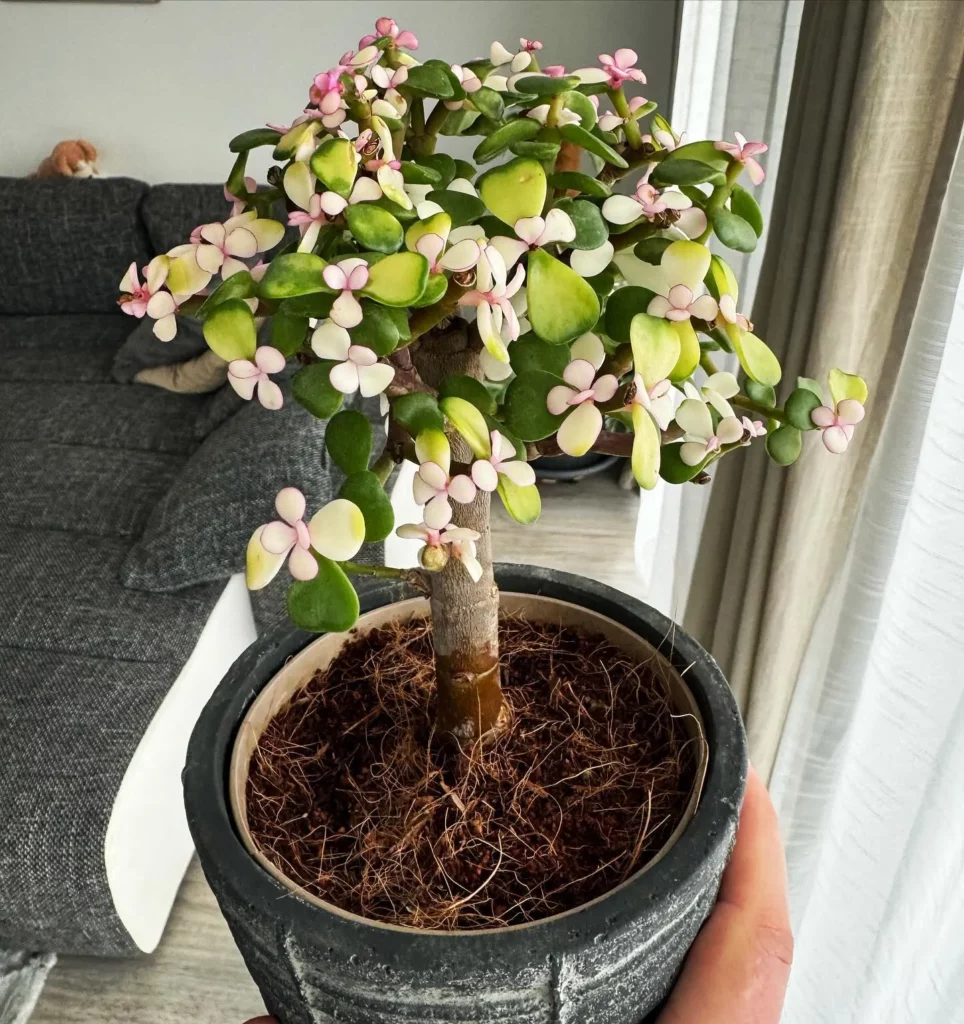
Pruning plays a crucial role in maintaining the leaf density and controlling the size of a jade bonsai tree. By strategically pinching off oversized leaves and removing leaf buds in undesired places, you can encourage the plant to develop new, smaller leaves. This helps to maintain the desired scale and proportion of the bonsai, creating a visually appealing aesthetic.
Regular trimming of leggy branches also stimulates the growth of clusters of new leaf buds, resulting in increased overall leaf density. The dense foliage enhances the lushness and fullness of the bonsai tree, creating a miniature masterpiece that exudes natural beauty.
When pruning for leaf density and size control, it is important to use sharp and clean pruning tools. Make precise cuts to ensure the health of the plant and prevent any damage or stress. Remember to remove any dead or yellowing leaves to maintain the bonsai’s vibrant and healthy appearance.
Pruning Techniques for Leaf Density and Size Control
Here are some effective pruning techniques to enhance leaf density and size control in your jade bonsai:
- Pinching: Use your fingers or pruning shears to pinch off oversized leaves. This technique encourages the growth of smaller leaves and prevents the bonsai from becoming excessively leafy.
- Leaf bud removal: Carefully remove leaf buds in areas where you don’t want new leaves to sprout. This helps redirect the plant’s energy to other parts of the bonsai, resulting in more balanced leaf growth.
- Trimming leggy branches: Trim back long and leggy branches to promote the growth of new leaf buds. This not only increases the leaf density but also improves the overall structure and balance of the bonsai tree.
No products found.
Optimizing Leaf Density and Size Control
Here are some additional tips to optimize leaf density and size control in your jade bonsai:
- Regular observation: Monitor the growth of your bonsai tree closely and assess its leaf density and size. This will help you identify areas that need pruning for better control.
- Consistent maintenance: Make pruning a regular part of your bonsai care routine. Regular maintenance ensures that your bonsai maintains its desired leaf density and size.
- Balance: Aim for a balanced distribution of leaves throughout the bonsai tree. Adjust pruning techniques accordingly to achieve a harmonious and visually pleasing composition.
- Patience: Leaf density and size control is a gradual process. It may take several pruning sessions and growing seasons to achieve the desired results. Practice patience and enjoy the journey of cultivating your jade bonsai tree.
With proper pruning techniques and attentive care, you can achieve exquisite leaf density and impeccable size control in your jade bonsai, creating a captivating masterpiece that showcases the artistry of nature.
Pruning for Branch and Trunk Thickness

Pruning is an essential technique for achieving branch and trunk thickness in your jade bonsai tree. By selectively pruning new branches and pinching off some leaves, you can redirect the plant’s energy to thicken and strengthen the desired areas. This process involves removing excess growth and allowing the trunk and branches to develop a thicker and sturdier structure over time.
To begin, carefully examine your bonsai tree and identify the branches and trunk sections that you want to thicken. You can use sharp pruning tools to make clean cuts and remove unwanted branches. It’s important to prune selectively, focusing on the areas that you want to promote growth. This will allow the plant’s resources to be concentrated in those specific areas, resulting in thicker branches and a more robust trunk.
Additionally, pinching off some leaves can help channel the plant’s energy towards thickening the branches and trunk. By removing a few leaves from the selected areas, you create a balance between foliage and branch development. This encourages the plant to allocate more nutrients and resources to the desired areas, resulting in thicker and stronger branches over time.
Consistency and patience are key when pruning for branch and trunk thickness. Regular and strategic pruning will stimulate new growth and gradually thicken the targeted areas. It’s important to monitor the progress of your bonsai tree and adjust your pruning approach as necessary to achieve the desired results.
Pruning for Bonsai Propagation
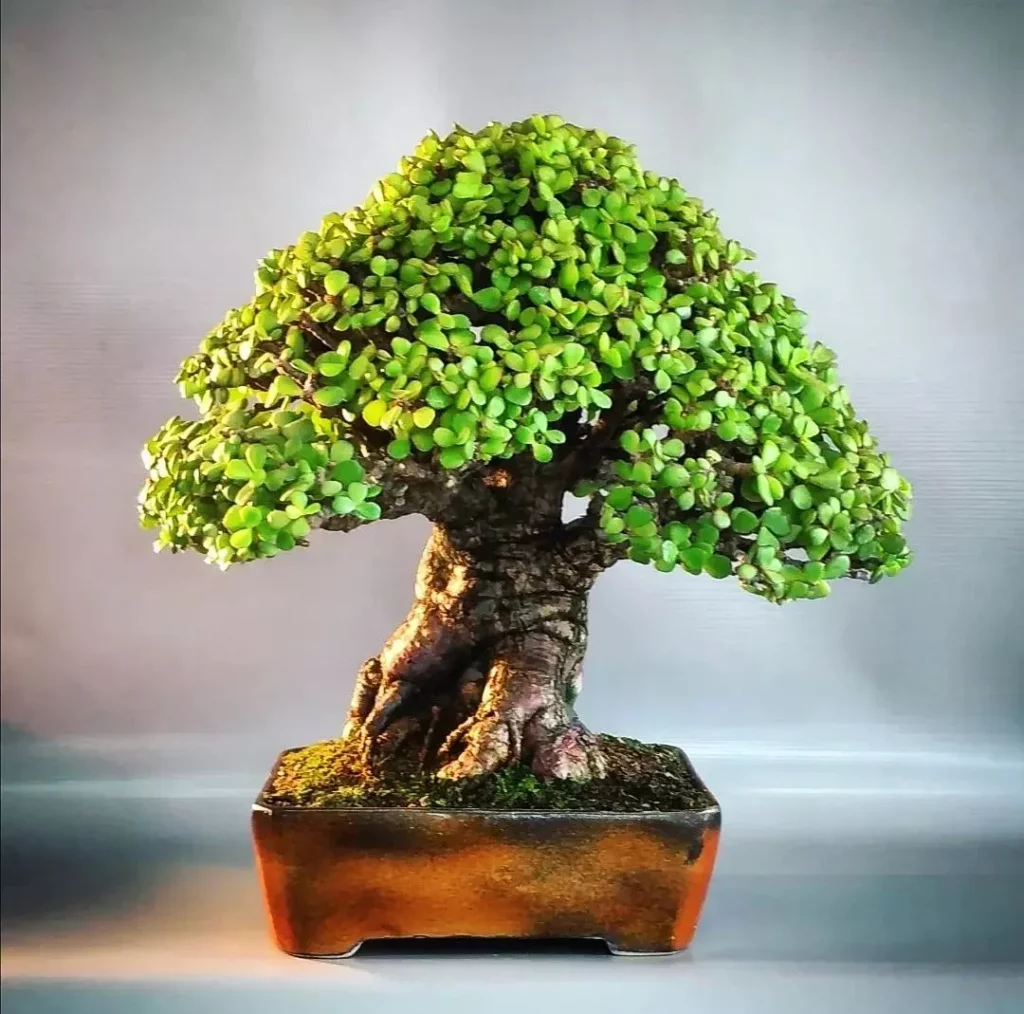
Pruning plays a crucial role in the propagation of bonsai trees, including jade bonsai. By carefully cutting branches or stems, you can create new plants from the pruned pieces, allowing you to expand your bonsai collection and share the joy of bonsai cultivation with others.
When it comes to bonsai propagation, freshly sprouted branches are ideal candidates. These young and vigorous branches can be carefully cut and planted to establish new jade bonsai trees. With proper care and nurturing, these new trees will grow and develop into stunning bonsai specimens.
No products found.
To ensure successful propagation through pruning, follow these steps:
- Select a healthy and robust branch that has recently sprouted and shows strong growth.
- Using sharp, sterile pruning shears, cleanly cut the selected branch just below a node or leaf junction.
- Prepare a small pot or container with well-draining bonsai soil or a mix of regular potting soil and perlite.
- Make a small hole in the soil and gently place the cut branch into it, ensuring that the cut end makes good contact with the soil.
- Firmly press the soil around the branch to secure it in place.
- Water the newly planted cutting thoroughly, ensuring that the soil is evenly moist but not waterlogged.
- Place the pot in a warm and bright location, but avoid direct sunlight to prevent scorching.
- Maintain consistent moisture levels in the soil by watering as needed, keeping in mind that overwatering can lead to root rot.
Pruning for Disease and Pest Management
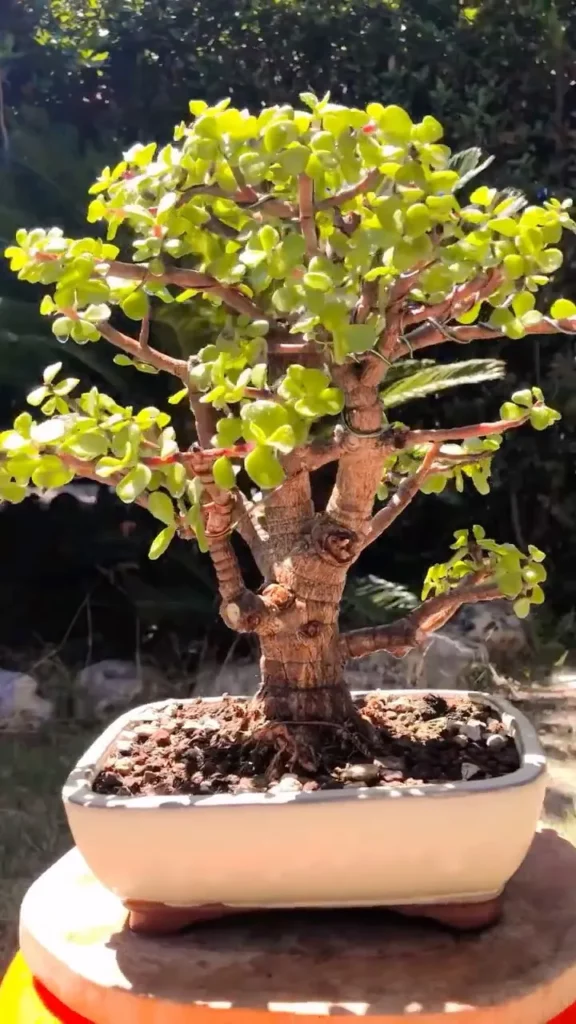
Pruning plays a crucial role in the management and prevention of diseases and pest infestations in jade bonsai trees. If your plant is under threat and does not recover on its own, pruning becomes necessary to eliminate affected branches or areas. By removing infected or damaged parts of the plant, you can stimulate new growth and enhance its overall vitality. Proper pruning techniques, coupled with regular inspection and maintenance, are key to keeping your jade bonsai trees healthy and resilient.
Benefits of Pruning for Disease and Pest Management
Pruning for disease prevention and pest control offers several advantages:
- Eliminates infected or damaged plant parts
- Promotes new growth and vitality
- Reduces the spread of diseases and pests
- Enhances the overall health and resilience of the plant
Pruning Techniques for Disease and Pest Management
When it comes to pruning for disease and pest management in jade bonsai trees, follow these techniques:
- Identify and mark infected or damaged areas
- Use sharp pruning tools to make clean cuts
- Ensure proper disposal of pruned material to prevent further contamination
- Monitor the plant closely for any signs of recurring diseases or pests
| Common Bonsai Diseases | Common Bonsai Pests |
|---|---|
| 1. Root rot | 1. Aphids |
| 2. Fungal infections | 2. Spider mites |
| 3. Leaf spot diseases | 3. Scale insects |
| 4. Powdery mildew | 4. Mealybugs |
| 5. Bacterial infections | 5. Caterpillars |
Growing Jade Bonsai as a Standard Tree

Jade bonsai trees can be grown as standard trees with tall trunks, creating a striking and elegant appearance. This unique style adds a sense of grandeur and refinement to your bonsai collection. To achieve this, you’ll need to follow a few essential steps.
Selecting the Right Plant
Start by choosing a young jade plant with a thick and strong stem. Look for a plant that has the potential to develop into a tall and robust trunk. A sturdy foundation is key to creating a standard tree bonsai.
Creating a Clean and Straight Form
To shape your jade bonsai as a standard tree, you’ll want to remove the lower branches and leaves from the selected trunk. This process creates a clean and straight form, mimicking the appearance of a full-sized tree. Prune carefully and make clean cuts to avoid damaging the plant.
Promoting New Growth
To encourage new shoots and a dense canopy, regular trimming of the upper branches is necessary. Prune the branches in a way that promotes upward growth and maintains the desired shape. This promotes the development of a lush and full crown.
Providing Support
During the early stages of growth, it’s important to provide support for the trunk to ensure it grows straight and upright. You can use a small stake or tie the trunk gently to a support structure. This will help the trunk develop strength and stability as it grows in height.
Growing Jade Bonsai as a Bonsai Forest

Jade bonsai trees can be a stunning addition to your bonsai collection when grown as a bonsai forest. This unique technique involves planting multiple bonsai trees in a single pot, creating a miniature forest-like scene right in your home or garden. By combining different bonsai forms and species, you can achieve a visually captivating and harmonious composition.
The key to successfully growing a bonsai forest is careful arrangement and pruning. Each individual tree should be strategically placed to create a sense of depth and balance within the composition. Consider varying the heights, trunk thickness, and foliage density to add visual interest and mimic the natural diversity found in forests.
Regular trimming and maintenance are essential to ensure the health and growth of each tree in the bonsai forest. Prune the trees to maintain their desired form, remove any dead or crossed branches, and encourage new growth. Pay close attention to the overall composition and adjust the arrangement as needed to maintain balance and harmony.
When selecting the species for your bonsai forest, choose trees that have similar growth habits and care requirements. This will make it easier to maintain and care for the entire forest. Keep in mind that each tree will still require individual attention, including watering, fertilizing, and repotting when necessary.
A bonsai forest is not only a beautiful creation but also a symbol of tranquility and the harmony found in nature. It can serve as a focal point in your home or garden, captivating the attention of anyone who sees it. Embrace the artistry of growing a jade bonsai forest and let your creativity flourish as you shape and nurture a living masterpiece.
Enjoying the Art of Shaping Jade Bonsai

Shaping jade bonsai is not just about horticulture; it is a form of art that allows for creative expression and artistic exploration. Each bonsai tree is a unique masterpiece that can be shaped according to your vision and aesthetic preferences. Whether you prefer a traditional or contemporary style, the process of shaping a jade bonsai tree is a delightful and rewarding journey.
To shape a jade bonsai tree, it requires patience, careful observation, and an understanding of the tree’s growth patterns. As you meticulously prune and trim the branches, you can mold the tree into your desired form. With each precise cut, you have the opportunity to bring your artistic vision to life, transforming a simple plant into a captivating work of art.
Through the art of bonsai, you can explore various techniques such as wiring, coiling, and pruning to create unique and visually striking compositions. Each bend of a branch and each carefully shaped leaf contribute to the overall beauty and expression of the bonsai tree.
When you engage in bonsai cultivation, you are not merely tending to a plant; you are embracing a form of artistic expression. The artistic aspect lies in the careful consideration of each element, from the placement of branches to the choice of container. Every decision you make in shaping your jade bonsai tree reflects your creativity and personal style.
Immerse yourself in the artistry of bonsai and allow your imagination to soar as you shape and refine your jade bonsai tree. Embrace the joy of creating a living work of art that brings tranquility, beauty, and a touch of nature to your surroundings.
No products found.
Tools for Shaping Jade Bonsai
| Tool | Description |
|---|---|
| Pruning shears | Used for precise trimming of branches and leaves. |
| Concave cutters | Designed to create clean and smooth cuts to promote healing and prevent scarring. |
| Wire cutters | Specifically designed to safely remove wire from branches without damaging the tree. |
| Bonsai wire | Used to gently shape and train branches into desired positions. |
| Bonsai rake | Helps to loosen and aerate the soil, ensuring proper drainage and root health. |
Embarking on Your Bonsai Journey

If you’re eager to start your own bonsai journey and shape your own jade bonsai tree, consider getting a bonsai tree kit. These kits provide all the necessary tools, seeds, and instructions for growing and shaping your own bonsai trees. They are suitable for beginners and experienced gardeners alike, offering a fun and hands-on approach to the ancient art of bonsai cultivation.
With a bonsai tree kit, you can immerse yourself in the fascinating world of bonsai and experience the joy of creating and nurturing your own miniature trees. Whether you’re a nature lover, an artist at heart, or simply looking for a rewarding hobby, starting bonsai cultivation with a kit is a great way to embark on your bonsai journey.
Beginners will appreciate the comprehensive guidance provided in a bonsai tree kit, which includes step-by-step instructions on how to grow and shape your bonsai tree. You’ll learn the techniques of pruning, wiring, and styling as you watch your tree transform into a unique and harmonious work of art.
So why wait? Start your bonsai adventure today with a jade bonsai starter kit and discover the endless possibilities of bonsai cultivation. Unleash your creativity, connect with nature, and nurture your own bonsai tree from a tiny seed to a magnificent living masterpiece. Your bonsai journey awaits!
FAQ
How do I shape a jade bonsai tree?
Shaping a jade bonsai tree involves pruning and wiring techniques. Pruning is done to maintain the desired shape and encourage new growth. Wiring can be used to gently manipulate the shape of branches. It is important to use sharp pruning tools and make clean cuts to avoid damaging the plant.
Why should I choose jade bonsai for beginners?
Jade bonsai, also known as dwarf jade or elephant bush, is an ideal choice for beginners because it is forgiving and low-maintenance. It can be easily shaped and grown into a beautiful tree. Additionally, it is a common and inexpensive plant, making it accessible to beginners who may not want to invest a lot of money in a mature bonsai tree.
How can I obtain a jade bonsai tree?
There are two common ways to obtain a jade bonsai tree. The first is to find a cutting from a friend or a store. Another option is to purchase a young jade bonsai tree, which provides a blank canvas for beginners to practice pruning and develop their artistic vision.
How do I propagate a jade bonsai cutting?
To propagate a jade bonsai cutting, remove the leaves from the bottom 2 inches of the cutting and place the stem in a glass with 2 inches of water. Once roots appear, plant the cutting in bonsai soil or regular cactus soil with good drainage. Choose a small pot with drainage holes and provide support until the roots are established.
How do I care for a newly planted jade bonsai?
Newly planted jade bonsai trees require adequate sunlight and warm, low-humidity environments. Place the bonsai in the sunniest spot available and water when the soil is dry. Avoid overwatering as jade plants are drought-tolerant. Prune and shape the bonsai regularly to maintain its desired form.
What are the basics of jade bonsai pruning?
Pruning is an essential part of shaping a jade bonsai tree. The first pruning should be done in spring or early summer when the plant is actively growing. Pruning techniques may vary depending on the desired shape of the tree. Use sharp pruning tools and make clean cuts to avoid causing damage to the plant.
What are the shaping techniques for jade bonsai?
Jade bonsai can be shaped using techniques such as wiring and coiling. Copper wire can be gently wrapped around branches to manipulate their shape. The wire should be removed once the desired shape is achieved to prevent marking the branches. These shaping techniques allow for artistic expression and unique bonsai forms.
How can I control leaf density and size on a jade bonsai?
Pruning and pinching techniques can be used to control leaf density and size on a jade bonsai tree. By removing oversized leaves and pruning leggy branches, the plant can be encouraged to develop new, smaller leaves. This helps maintain the desired scale and proportion of the bonsai.
How do I thicken branches and trunk on a jade bonsai?
Pruning is an important technique for thickening branches and trunk on a jade bonsai tree. By selectively pruning new branches and pinching off some leaves, the plant’s energy can be directed towards thickening the desired areas. This process requires patience and consistent pruning.
Can pruning be used for bonsai propagation?
Yes, pruning can be used for bonsai propagation. By cutting branches or stems, new plants can be propagated from the pruned pieces. Freshly sprouted branches are ideal for propagation, as they can be cut and planted to create new jade bonsai trees.
How can pruning help manage disease and pest infestations in jade bonsai trees?
Pruning can help manage and prevent disease and pest infestations in jade bonsai trees. If the plant is threatened by disease or pests and does not recover on its own, it may be necessary to prune affected branches or areas. Proper pruning techniques, along with regular inspection and maintenance, can help keep jade bonsai trees healthy and resilient.
Can jade bonsai be grown as a standard tree?
Yes, jade bonsai trees can be grown as standard trees with tall trunks. Select a young plant with a thick and strong stem, and remove lower branches and leaves to create a clean, straight form. Regular trimming of the upper branches promotes new shoots and a dense canopy.
Can jade bonsai be grown as a bonsai forest?
Yes, jade bonsai trees can be grown as a bonsai forest by planting multiple trees in a single pot. Carefully arrange and prune the trees to maintain the desired composition and balance. Regular trimming and maintenance are necessary to ensure the health and growth of each tree in the bonsai forest.
How can I enjoy the art of shaping jade bonsai?
Shaping jade bonsai is not only a horticultural practice but also an art form that allows for artistic expression and creativity. Each bonsai tree is unique and can be shaped according to the grower’s vision and aesthetic preferences. The process requires patience, observation, and an understanding of the tree’s growth patterns.
How can I embark on my bonsai journey?
If you’re eager to start your own bonsai journey and shape your own jade bonsai tree, consider getting a bonsai tree kit. These kits provide all the necessary tools, seeds, and instructions for growing and shaping your own bonsai trees. They are suitable for beginners and experienced gardeners alike, offering a fun and hands-on approach to the ancient art of bonsai cultivation.

